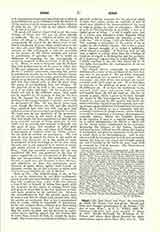

Sinai, (Hebrew: SYNY, Greek: Sina, Sinai and Sina), the mountain on which the Mosaic Law was given. Horeb and Sinai were thought synonymous by St. Jerome (“De situ et nom. Hebr.”, in P.L., XXIII, 889), W. Gesenius (Hebrew: CHRB SYNY), and, more recently, G. Ebers (p. 381). Ewald, Delitzsch, Ed. Robinson, E. H. Palmer, and others think Horeb denoted the whole mountainous region about Sinai (Ex., xvii, 6). The origin of the name Sinai is disputed. It seems to be an adjective from Hebrew: SYN, “the desert” (Ewald and Ebers) or “the moon-god” (E. Schrader and others). The mount was called Sinai, or “the mount of God” probably before the time of Moses (Josephus, “Antiq. Jud.”, II, xii.) The name is now given to the triangular peninsula lying between the desert of Southern Palestine, the Red Sea, and the gulfs of Akabah and Suez, with an area of about 10,000 sq. miles, which was the scene of the forty years’ wandering of the Israelites after the Exodus from Egypt.
The principal topographical features are two. North of the Jabal et-Tih (3200 to 3950 feet) stretches an arid plateau, the desert of Tih, marked by numerous Wadis, notably El-Arish, the “River of Egypt” which formed the southern boundary of the Promised Land (Gen., xv, 18; Num., xxxiv, 5). South of Jabal et-Tih rises a mountainous mass of granite streaked with porphyry, dividing into three principal groups: the western, Jabal Serbal (6750 feet); the central, Jabal Mtisa (7380 feet), Jabal Catherine (8560 feet), and Jabal Urn Schomer (8470 feet); the eastern, Jabal Thebt (7906 feet) and Jabal Tarfa, which terminates in Ras Mohammed. It is among these mountains that Jewish and Christian tradition places the Sinai of the Bible, but the precise location is uncertain. It is Jabal Milsa, according to a tradition traceable back to the fourth century, when St. Silvia of Aquitaine was there. Jabal M11sa is defended by E. H. and H. S. Palmer, Vigouroux, Lagrange, and others. However, the difficulty of applying Ex., xix, 12, to Jabal M11sa and the inscriptions found near Jabal Serbal have led some to favor Serbal. This was the opinion of St. Jerome (P.L., XXIII, 916, 933) and Cosmas (P.G., LXXXVIII, 217), and more recently of Burkhard and Lepsius, and it has of late been very strongly defended by G. Ebers, not to mention Beke, Gressmann, and others, who consider the whole story about Sinai (Ex., xix) only a mythical interpretation of some volcanic eruption. The more liberal critics, while agreeing generally that the Jewish traditions represented by the “Priest-codex” and “Elohistic documents” place Sinai among the mountains in the south-central part of the peninsula, yet disagree as to its location by the older “Jahvistic” tradition (Ex., ii, 15, 16, 21; xviii, 1, 5). A. von Gall, whose opinion Welhausen thinks the best sustained, contends that Meribar (D. V. Temptation.—Ex., xvii, 7) is identical with Cades (Num., xxxiii, 36; xxvii, 14), that the Israelites never went so far south as Jabal Mitsa, and hence that Sinai must be looked for in Madian, on the east coast of Akabar. Others (cf. Winckler, II, p. 29; Smend, p. 35, n. 2; and Weill, opp. cit. infra in bibliography) look for Sinai in the near neighborhood of Cades (Ayn qadis) in Southern Palestine.
Sinai was the refuge of many Christian anchorites during the third-century persecutions of the Church. There are traces of a fourth-century monastery near Mount Serbal. In 527 the Emperor Justinian built the famous convent of Mt. Sinai on the north foot of Jabal Miisa, which has been known since the ninth century as St. Catherine’s. Its small library contains about 500 volumes of valuable manuscripts in Greek, Arabic, Syriac, Ethiopic, etc. It was here that Tischendorf, during his researches in 1844, 1853, and 1859, found a very ancient Greek MS. (since known as the “Codex Sinaiticus”) containing most of the Septuagint, all the new Testament, the “Epistle of Barnabas“, and the first part of the “Shepherd” of Hermas. Forty-three MS. pages found by him are preserved at the University of Leipzig and known as the “Codex Friderico-Augustanus”. In 1892 Mrs. Smith Lewis found at Sinai a fourth-century palimpsest Syriac text of St. Luke’s Gospel. Sinai is rich in valuable inscriptions. M. de Voglie gives 3200 Egyptian and Semitic inscriptions found in the Wadi Mukatteb, the ruins of the temple of Ischta, or Astaroth-Carmain, and the iron and turquoise mines and granite and marble quarries, which were extensively worked under the twelfth and eighteenth Egyptian dynasties.
The present population of Sinai is 4000 to 6000 semi-nomadic Arabs, Mohammedans, governed by their tribal sheikhs and immediately subject to the commandant of the garrison at Qar at un-Nakhl, under the Intelligence Department of the Egyptian War Office at Cairo.
NICHOLAS REAGAN

